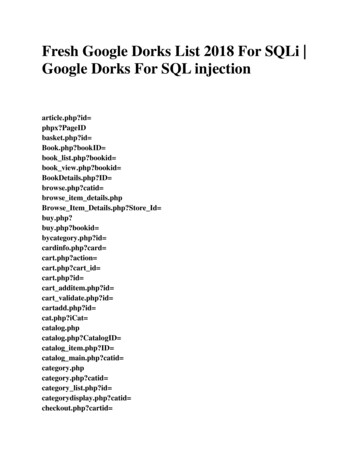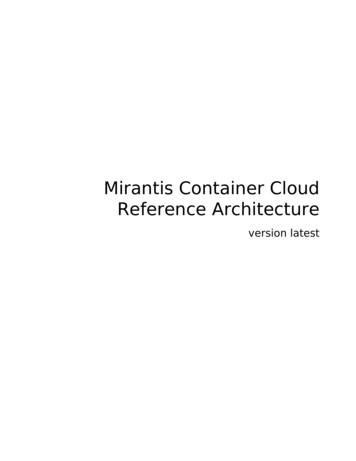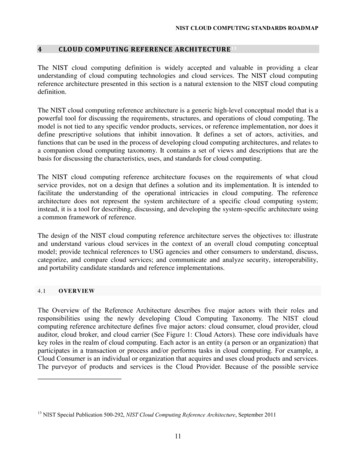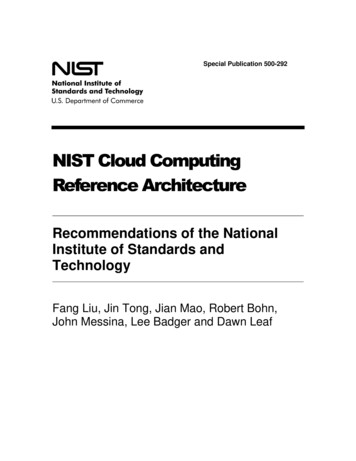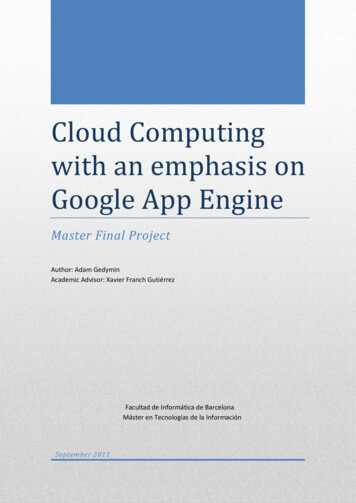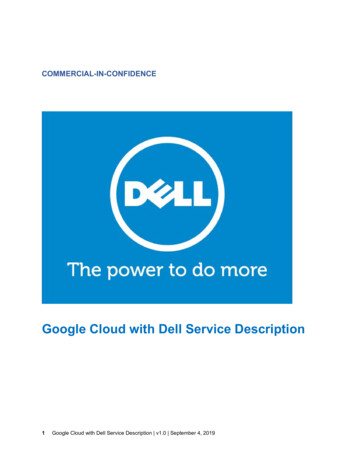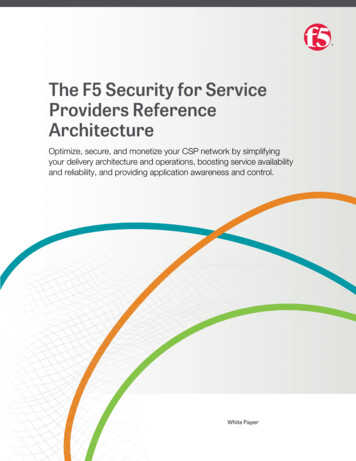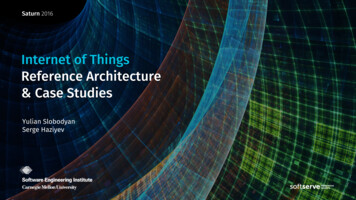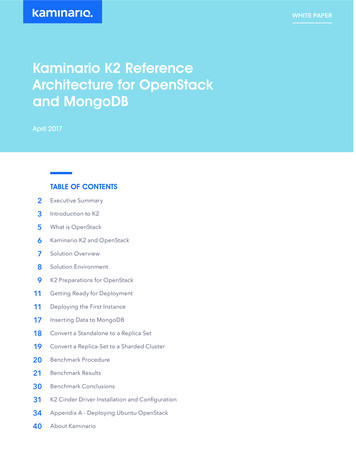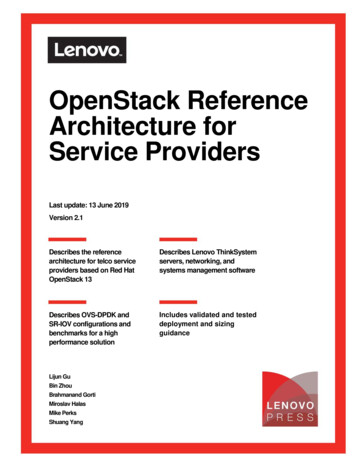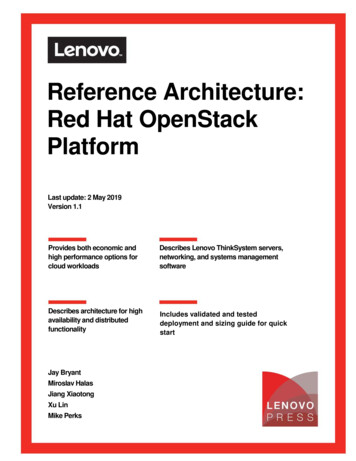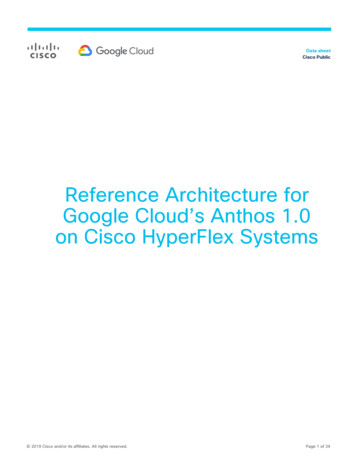
Transcription
Data sheetCisco PublicReference Architecture forGoogle Cloud’s Anthos 1.0on Cisco HyperFlex Systems 2019 Cisco and/or its affiliates. All rights reserved.Page 1 of 34
ContentsExecutive summary . 3Technology overview . 5Solution overview . 11Anthos on Cisco HyperFlex systems reference architecture . 12Prerequisites for deploying Anthos on VMware on Cisco HyperFlex system . 16Anthos on VMware deployed on Cisco HyperFlex system . 17Deployment configuration example . 27Conclusion . 33For more information . 34 2019 Cisco and/or its affiliates. All rights reserved.Page 2 of 34
Executive summaryGoogle Cloud’s Anthos is a modern application-management and hybrid-cloud technology platform fromGoogle Cloud. Anthos enables deployment of some of the main public-cloud capabilities in customers’ own onpremises data centers. One of the core components of Anthos is the on-premises version of the popularGoogle Kubernetes Engine (GKE) container orchestrator, Anthos on VMware, which enables the development ofmodern applications based on microservices architecture. Customers have the flexibility to develop and testtheir workloads on-premises and later decide to deploy them: either on-premises or in the public cloud.Multiple different cloud providers support the use Kubernetes clusters. In addition to Anthos GKE, Anthosincludes other software capabilities such as Anthos Service Mesh (service management), Anthos ConfigManagement (policy management), Stackdriver (operation management), and Google Cloud PlatformMarketplace and Cloud Run for Anthos (application development).One of the main on-premises components required to deploy Anthos is an infrastructure platform. Cisco haspartnered with Google Cloud to validate the Cisco HyperFlex hyperconverged infrastructure (HCI) platform forAnthos. Cisco HyperFlex systems with VMware are certified HCI servers with a comprehensive set of optionsconfigurable depending on application workload and business needs. Cisco HyperFlex HCI provides a commonbuilding block for Kubernetes-based applications as well as virtualized workloads. Cisco infrastructure isoptimized to run Anthos. When a Cisco HyperFlex or Cisco HyperFlex Edge system is used with Anthos, thetechnologies work together to provide a consistent experience whether in an on-premises environment, inGoogle Cloud, or in other public clouds (future). Anthos provides a ubiquitous platform that is consistent,secure, and reliable across environments.This document provides a technical overview of the Anthos on-premises solution. The document describes thereference architecture for an Anthos on-premises deployment with Cisco HyperFlex HCI. It provides high-levelimplementation details.The document also provides an example of a multitier application deployment to demonstrate the microservicesarchitecture. The application used in the demonstration is composed of multiple microservices written indifferent languages that can talk to each other over gRPC, a popular open-source remote procedure call (RPC)developed by Google. 2019 Cisco and/or its affiliates. All rights reserved.Page 3 of 34
Business challengesOrganizations today want to accelerate innovation by developing and modernizing applications withmicroservices across the data center and remote, edge, and public-cloud environments to take advantage ofemerging technologies. To achieve this, organizations need the flexibility to build a hybrid cloud that deliversagility and innovation. Configuring and managing Kubernetes across hybrid-cloud environments can becomplicated, because it requires manual effort and multiple tools for clustering, networking, monitoring,security, etc.The main technical challenges can be addressed with the following capabilities that this combined solutionoffers: Easily deploy Kubernetes-based applications in on-premises (including edge) environments usingthe Cisco HyperFlex hyperconverged platform. Establish a common and secure Kubernetes experience across the on-premises environment andpublic cloud. Provide a single administrative control plane for centralized policy and security across clouds. Extend existing on-premises applications and infrastructure into the public cloud without increasingrisk and complexity. Increase application agility with access to industry-leading tools, technologies, and platforms fromGoogle Cloud and Cisco. Enable access to a broader choice of applications from the cloud marketplace for on-demandconsumption. 2019 Cisco and/or its affiliates. All rights reserved.Page 4 of 34
Technology overviewThis section provides an overview of the hardware and software used for an Anthos on-premises deploymenton Cisco HyperFlex infrastructure.Cisco HyperFlex systemsCisco HyperFlex systems are deployed as a preintegrated cluster with a unified pool of resources that can bequickly provisioned, adapted, scaled and managed. They are bundled with hybrid small-form-factor (SFF),large-form-factor (LFF), or all-flash storage configurations and a choice of management tools. Cisco HyperFlexsystems include Cisco Unified Computing System (Cisco UCS ) M5 rack servers, based on secondgeneration Intel Xeon Scalable processors. These fifth-generation servers have faster processors, morecores, and faster and larger-capacity memory than previous-generation servers. In addition, they are ready forIntel 3D XPoint nonvolatile memory, which can be used as both storage and system memory, increasing yourvirtual server configuration options and flexibility for applications.Physically, the system is delivered as a cluster of three or more Cisco HyperFlex HX240c M5 Nodes, HX240cM5 LFF Nodes, or HX240c M5 All Flash Nodes that are integrated into a single system by a pair of Cisco UCS6200 or 6300 Series Fabric Interconnects.Cisco HyperFlex HX240c M5 All Flash NodeThis solution uses Cisco HyperFlex M5 all-flash servers. The Cisco HyperFlex HX240c M5 All Flash Node(Figure 1) is excellent for balanced-performance and capacity clusters.Figure 1.Cisco HyperFlex HX240c All Flash Node: Front with bezelThe HX240c M5 All Flash servers extend the capabilities of the Cisco HyperFlex portfolio in a 2-rack-unit (2RU)form factor with the addition of the second-generation Intel Xeon Scalable family processors, supporting up to28 cores per CPU, 24 DIMM slots with configuration options ranging from 128 GB to 3 TB of DRAM (with 128GB DIMMs), and an all-flash footprint of cache and capacity drives for highly available, high-performancestorage.For more information about the HX240c M5 All Flash Node, eries/datasheet-c78-736784.pdf.Cisco HyperFlex HX Data Platform softwareCisco HyperFlex HX Data Platform is a hyperconverged software appliance that transforms Cisco servers into asingle pool of computing and storage resources. It eliminates the need for network storage and tightlyintegrates with VMware vSphere and its existing management application to provide a seamless datamanagement experience. In addition, native compression and deduplication reduce storage space occupied bythe virtual machines.Cisco HyperFlex systems deliver a new generation of flexible, scalable, enterprise-class hyperconvergedsolutions. This solution also delivers storage efficiency features such as thin provisioning, data deduplication, 2019 Cisco and/or its affiliates. All rights reserved.Page 5 of 34
and compression for greater capacity and enterprise-class performance. Additional operational efficiency isfacilitated through features such as cloning and snapshots. The HX Data Platform can be administered through aVMware vSphere web client plug-in or through the HTML5-based native Cisco HyperFlex Connect managementtool.HX Data Platform consists of the following components: Cisco HyperFlex HX Data Platform Installer: Download this installer to a server connected to thestorage cluster. The HX Data Platform Installer configures the service profiles and policies withinCisco UCS Manager, deploys the controller virtual machines, installs the software, creates thestorage cluster, and updates the VMware vCenter plug-in. Storage controller virtual machine: The HX Data Platform Installer installs the storage controllervirtual machine on each converged node in the managed storage cluster. Cisco HyperFlex HX Data Platform Plug-in: This integrated VMware vSphere interface monitors andmanages the storage in your storage cluster.Cisco Intersight platform for Cisco HyperFlex systemsThe Cisco Intersight platform simplifies data center operations by delivering systems management as aservice, alleviating the need to maintain islands of on-premises management infrastructure.The Cisco Intersight platform provides an installation wizard to install, configure, and deploy Cisco HyperFlexclusters, attached with Cisco HyperFlex Edge and Cisco UCS fabric interconnects. The wizard constructs apreconfiguration definition of your cluster called a Cisco HyperFlex cluster profile. This definition is a logicalrepresentation of the Cisco HyperFlex HX-Series nodes in your Cisco HyperFlex cluster. It includes thesefeatures: Security: Credentials for the Cisco HyperFlex cluster such as the controller virtual machine passwordand the hypervisor user name and password Configuration: Server requirements, firmware, etc. Connectivity: Upstream network, virtual network, etc.The main features and benefits of the Cisco Intersight platform include the following: Unified management Simplify Cisco UCS and Cisco HyperFlex management with a single management platform. Scale across data centers and remote locations without additional complexity. Configuration, provisioning, and server profiles Create multiple server profiles with just a few clicks or through the available API, automating theprovisioning process. Create, deploy, and manage your Cisco HyperFlex configurations. Help ensure consistency and eliminate configuration drift, maintaining standardization across manysystems. Inventory information and status Display and report inventory information for Cisco UCS and Cisco HyperFlex systems. Monitor Cisco UCS and Cisco HyperFlex server alerts and health status across data centers and remotelocations. 2019 Cisco and/or its affiliates. All rights reserved.Page 6 of 34
View your Cisco HyperFlex configurations. Track and manage firmware versions across all connected Cisco UCS and Cisco HyperFlex systems. Track and manage software versions and automated patch updates for all claimed Cisco UCS Directorsoftware installations. Enhanced support experience Get automated alerts about failure notifications. Automate the generation and forwarding of technical support files to the Cisco Technical AssistanceCenter (TAC) to accelerate the troubleshooting process. Open API The representational state transfer (REST) API supports the Open API Specification (OAS) to providefull programmability and deep integration of systems. The Python and PowerShell software development kits (SDKs) enable integration with DevOps and IToperations management (ITOM) tools. Seamless integration and upgrades Upgrades are available for Cisco UCS, Cisco HyperFlex, and Cisco UCS Director systems softwarerunning supported firmware and software versions. Upgrades to the Cisco Intersight platform are delivered automatically without disruption of youroperations.Cisco UCS ManagerCisco UCS Manager is embedded software that resides on a pair of fabric interconnects and provides completeconfiguration and management capabilities for Cisco HyperFlex HX-Series servers. The most common way toaccess Cisco UCS Manager is to use a web browser to open the GUI. Cisco UCS Manager supports role-basedaccess control (RBAC).A critical benefit of Cisco UCS Manager is its application of stateless computing. Each node in an HX-Seriescluster has no set configuration. MAC addresses, universally unique IDs (UUIDs), firmware, and BIOS settings,for example, are all configured on Cisco UCS Manager in a service profile and applied uniformly to all the HXSeries servers. This approach enables consistent configuration and configuration that can easily be reused.Cisco UCS fabric interconnectsCisco UCS fabric interconnects provide the management and communication backbone for the Cisco HyperFlexHX-Series rack-mount servers and Cisco UCS B-Series Blade Servers and Cisco UCS 5100 Series BladeServer Chassis.Cisco UCS 6300 Series Fabric Interconnects support high-performance, low-latency, lossless, line-rate 40Gigabit Ethernet, with up to 2.56 Tbps of switching capacity. Backward compatibility and scalability are assuredwith the capability to configure 40-Gbps Quad Small Form-Factor Pluggable (QSFP) ports as breakout portsusing four 10 Gigabit Ethernet breakout cables. Existing Cisco UCS servers with 10 Gigabit Ethernet interfacescan be connected in this manner, although Cisco HyperFlex nodes must use a 40 Gigabit Ethernet virtualinterface card (VIC) adapter to connect to a Cisco UCS 6300 Series Fabric Interconnect. 2019 Cisco and/or its affiliates. All rights reserved.Page 7 of 34
Cisco UCS virtual interface cardsThe Cisco UCS VIC 1385 card works with Cisco Nexus Family 40 and 10 Gigabit Ethernet switches for highperformance applications. The Cisco UCS VIC 1385 implements the Cisco Data Center Virtual Machine FabricExtender (VM-FEX), which unifies virtual and physical networking into a single infrastructure. The extenderprovides virtual machine visibility from the physical network and a consistent network operations model forphysical and virtual servers. The modular LAN-on-motherboard (mLOM) slot can be used to install a Cisco UCSVIC without consuming a PCI Express (PCIe) slot, thus providing greater I/O expandability.The Cisco UCS VIC 1387 is a dual-port Enhanced QSFP (QSFP ) 40-Gbps Ethernet and Fibre Channel overEthernet (FCoE)–capable PCIe mLOM adapter installed in the HX-Series rack servers. The VIC 1387 is used inconjunction with the Cisco UCS 6332 or 6332-16UP Fabric Interconnect.Cisco Nexus Family switchesCisco Nexus 9000 Series Switches can scale to up to 30 Tbps of nonblocking performance with latency of lessthan 5 microseconds, 1152 x 10-Gbps or 288 x 40-Gbps nonblocking Layer 2 and Layer 3 Ethernet ports, andwire-speed Virtual Extensible LAN (VXLAN) gateway, bridging, and routing capabilities.VMware vCenter managementCisco HyperFlex systems use VMware vCenter–based management. The vCenter Server is a data centermanagement server application developed to monitor virtualized environments. The HX Data Platform is alsoaccessed from the preconfigured vCenter Server to perform all storage tasks. vCenter supports shared storagefeatures such as VMware vMotion, Distributed Resource Scheduler (DRS), High Availability (HA), and vSpherereplication. More scalable, native HX Data Platform snapshots and clones replace VMware snapshots andcloning capabilities.You must have vCenter installed on a separate server to access HX Data Platform. vCenter is accessed throughthe vSphere Client, which is installed on the administrator’s laptop or PC.F5 BIG-IP Virtual EditionF5 BIG-IP Virtual Edition (VE) is a virtual application delivery controller (vADC) that can be deployed on allleading hypervisors and cloud platforms running on commodity servers. BIG-IP VE delivers all the same marketleading application delivery services—including advanced traffic management, acceleration, Domain NameSystem (DNS), firewall, and access management—that run on F5 purpose-built hardware. VE software imagesare downloadable and portable among on-premises virtualized data center, public-cloud, and private-cloudenvironments. With BIG-IP VE, you can rapidly provision consistent application services across the data centerand into the cloud.F5 BIG-IP Local Traffic Manager (LTM) helps you deliver your applications to your users in a reliable, secure,and optimized way. With BIG-IP LTM, you have the power to simplify, automate, and customize applicationservices faster and more predictably. BIG-IP LTM enables you to control network traffic, selecting the rightdestination based on server performance, security, and availability.F5 BIG-IP integrates with Anthos on-premises, making it the recommended choice (Figure 2). F5 applicationservices can be readily applied to containers running within Anthos. Using F5 Container Ingress Services, whichintegrates natively with the Kubernetes orchestrator, and BIG-IP, customers can deliver F5’s broad suite oftraffic management and security services to their containers while easily orchestrating application servicesinsertion. On-premises container workloads can now be easily moved and scaled across Anthos GKE, while F5works with Kubernetes to help ensure that your on-premises applications receive the advanced services theyrequire. 2019 Cisco and/or its affiliates. All rights reserved.Page 8 of 34
Figure 2.F5 BIG-IP for Anthos on VMwareAnthos on VMwareAnthos on VMware is hybrid-cloud software that brings GKE to on-premises data centers. With Anthos onVMware, you can create, manage, and upgrade Kubernetes clusters in your on-premises environment throughthe Anthos cloud-based management plane.Anthos helps accelerate application development by bringing your code into production reliably, securely, andconsistently with low risk, helping enable your business strategically.Figure 3 shows the main components of Anthos GKE. In the figure you can see that the components running onGoogle Public Cloud are mainly the same as those that are running on the on-premises cloud. Hence, theAnthos clusters running in the on-premises data center are essentially an extension of the public cloud. This iswhy Anthos’ approach is unique and the best in its class. As soon as the Anthos on-premises cluster isdeployed and connected to Google Cloud Platform, the hybrid cloud is ready for operation.GKE Connect connects the on-premises Kubernetes clusters or the Kubernetes clusters running on other publicclouds with the Google Cloud. GKE Connect uses an encrypted connection between the Kubernetes clustersand Google Cloud Platform. It enables authorized users to log in to clusters; access details about theirresources, projects, and clusters; and manage cluster infrastructure and workloads independent of thehardware they are running. The GKE Connect Agent is installed in the on-premises Kubernetes cluster. It isauthenticated and then the encrypted connection with Google Cloud Platform is established without any publicIP address. The Google Cloud Platform Virtual Private (VPC) and Google Cloud Interconnect provide secureconnectivity and controls to enable Google Cloud Platform to be an extension of the on-premise cloud. 2019 Cisco and/or its affiliates. All rights reserved.Page 9 of 34
Figure 3.Anthos GKE architecture 2019 Cisco and/or its affiliates. All rights reserved.Page 10 of 34
Solution overviewThe primary computing environment for Anthos relies on Anthos GKE to manage Kubernetes installations in bothcloud and on-premises environments in which you intend to
Cisco UCS 6300 Series Fabric Interconnects support high-performance, low-latency, lossless, line-rate 40 Gigabit Ethernet, with up to 2.56 Tbps of switching capacity. Backward compatibility and scalability are assured with the capability to configure 40-Gbps Quad Small
